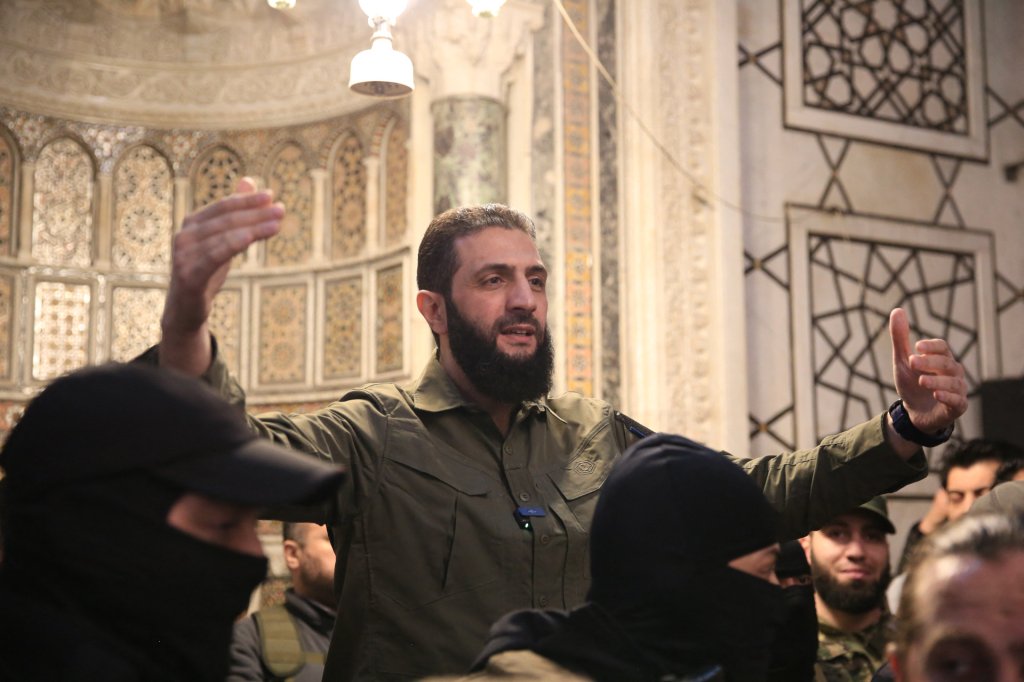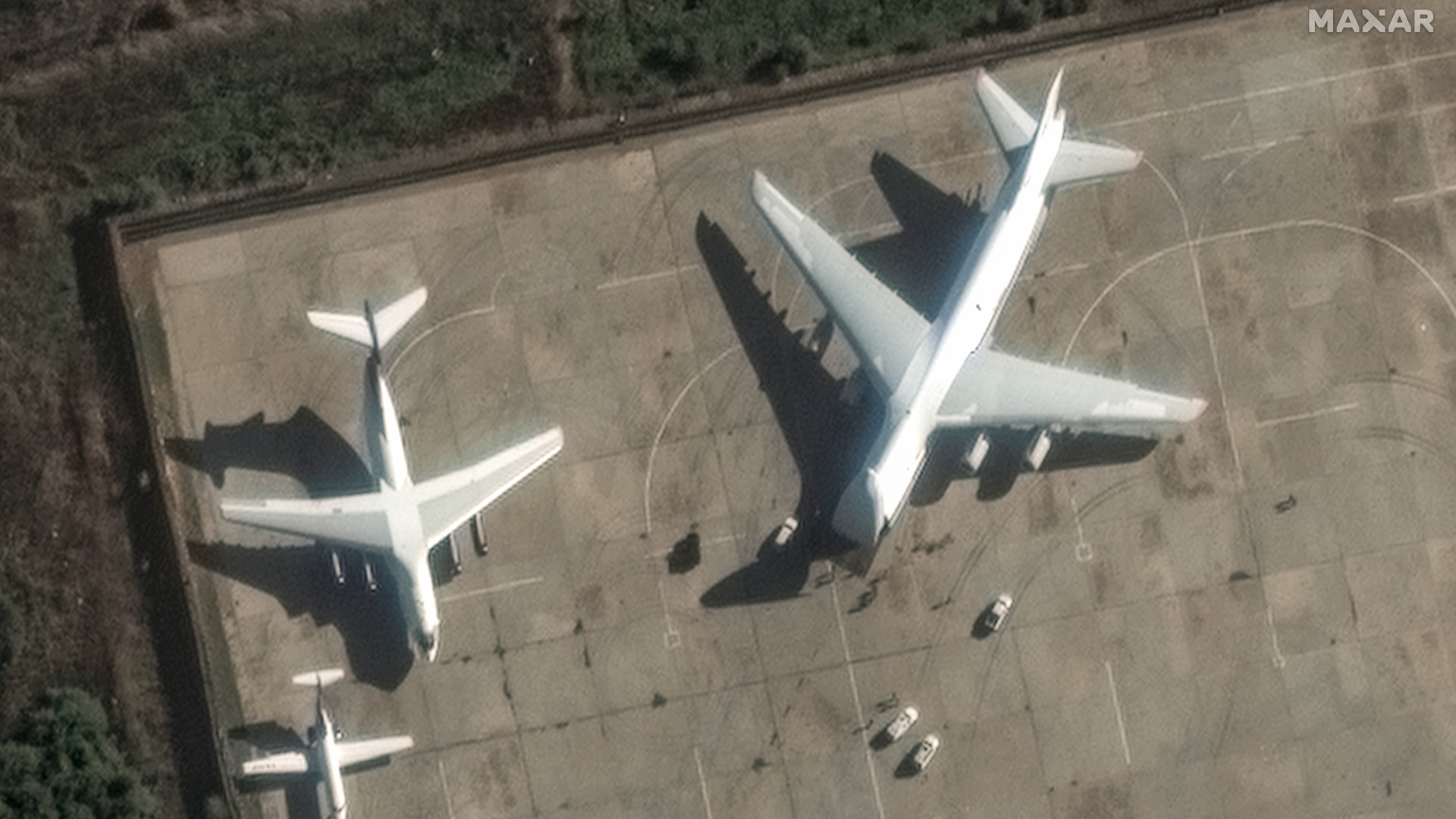There are clear signs that Russian forces, including an S-400 surface-to-air missile system, are withdrawing from Khmeimim Air Base in Syria. At the same time, authorities in Russia continue to insist that no final decisions have been made about the future of their presence at Khmeimim or their naval base in Tartus since the fall of their long-time ally Bashar Al Assad last weekend. These are highly strategic and irreplaceable locations the Kremlin uses to project military power well beyond Syria.
Satellite imagery taken today of Khmeimim (also written Hmeimim) that The War Zone obtained from Maxar provides the latest evidence that a withdrawal of at least some Russian forces from the base is underway now. As seen at the top of this story and below, two very large An-124 airlifters are prominently visible at the base with their noses open, appearing to be ready to load cargo. There are also three Il-76 Candid cargo planes parked on a large open apron at the northeast end of the facility.

At least one of the Il-76s presently at Khmeimim is a Syrian Airlines aircraft and a Yakovlev Yak-40 airliner, which the Syrian flag carrier also has in its inventory, looks to be parked next to it. Smaller An-72 Coaler and An-26 Curl transports, as well as a Su-35 Flanker-E fighter, are also seen in the imagery. There may be more tactical jets under the row of shelters at the northeastern end of the base.

The Maxar images also show Russian forces are packing up the S-400 surface-to-air missile site at Khmeimim, as well as other air defense assets. What looks to be a Ka-52 attack helicopter is also seen with its rotor blades removed, likely for transport.


A video of Khmeimin shot using a drone, which Turkey-based Syria TV put out previously and is now widely circulating online, had already shown a flurry of activity at the base. Russian Il-76s, as well as the Syrian Airlines one, and the An-72 are also visible in that footage, along with four Su-34 Fullback, seven Su-24 Fencer, and four Flanker-series combat jets. A contingent of MiG-31 Foxhound combat jets that been at the base reportedly left days ago.
The footage from Syria TV also notably showed a trailer-mounted 91N6 Big Bird S-band surveillance and tracking radar, a component of the S-400 surface-to-air missile system, in its travel configuration parked on the side of the open apron. This pointed to plans to load it onto the aircraft for movement elsewhere. Other elements of the S-400 system at Khmeimim were still visible in their emplacements, but did not appear to be in a deployed mode. For instance, transport erector launchers were seen in travel configurations with their missile tubes down, as well. All of this is in line with what is seen in the new Maxar imagery.
Other video footage circulation online indicates that Russian forces from elsewhere in Syria are converging on Khmeimim, possibly for further withdrawal from the country.
What may be happening at Tartus is less clear. Russian naval vessels left the port days ago, but had been holding offshore rather than moving to leave the region entirely. Newer satellite imagery shows that the ships remain in the area, but have dispersed even further.
An additional image The War Zone obtained from Maxar of Tartus that was taken today shows the continued absence of Russian warships, but also at least some air defense assets still in place.


Other video footage that has appeared online has also shown that at least some Russian forces remain ashore at Tartus and are actively holding the facility. Additional Russian units also look to be headed there, again possibly for withdrawal out of the country.
Whether or not the Russian military is moving to vacate Khmeimim and Tartus completely remains unclear. As The War Zone has previously noted, moving ships out of Tartus is a prudent force protection measure given the current fluidity of the situation in Syria. Even if major rebel groups have given the Kremlin certain security guarantees, the ships would still be huge and relatively defenseless targets sitting pierside.
The Syria TV footage of Khmeimim only underscores the current unprecedented freedom of access in Syria after decades of the country being a brutal totalitarian police state, as well as the potential risks this brings to Russian bases in the country. The War Zone reports often about the ever-growing threat of drone attacks, including ones launched by actors relatively close by, especially on air bases and other critical facilities, in general. A mass drone attack on Khmeimim in 2018 was a major herald of things to come and the base has a long history of being subjected to indirect fire of various kinds by rebel forces.
The departure of air defense assets from Khmeimim, especially point-defense systems, will only increase the vulnerability of that base to aerial threats. That, in turn, could point to more serious withdrawal plans. Even if Russia ultimately retains its bases in Syria, it is still very possible that its overall force posture in the country could change, as well.
As The War Zone has stressed before, Russia losing Khmeimim and Tartus would be a huge blow to Russia with ramifications well beyond Syria. Assad has essentially gifted the facilities to the Russian government through a 49-year ‘lease’ deal in 2017 and the Kremlin has invested considerable resources in expanding them since then. The bases offer highly strategic nodes for projecting air and naval power into the Mediterranean, including along NATO’s southern flank, and into Africa, as well as elsewhere in the Middle East. Tartus is especially significant because it is the Russian Navy’s only current warm-water port facility with direct access to the Mediterranean, but Khmeimim is also a uniquely positioned operating location for the country’s air force.
Bloomberg reported earlier today that Russia’s Foreign Ministry “believes it has an informal understanding” with the new transitional government emerging in Damascus, which rebel group Hay’at Tahrir al-Sham (HTS) is leading, about keeping Khmeimim and Tartus. There have been previous reports that Russian authorities secured guarantees of access to both facilities, at least for some amount of time, during talks with various regional actors about the political transition ongoing in Syria.
“The bases are still there, where they were on Syrian territory,” Russian Deputy Foreign Minister Mikhail Bogdanov told reporters earlier this week, according to the country’s Interfax news agency. “No other decisions have been made for the moment.”
“They [the bases] were there at the Syrians’ request with the aim of fighting terrorists from the Islamic State [IS]. I am proceeding on the basis of the notion that everyone agrees that the fight against terrorism, and what remains of IS, is not over,” Bogdanov added. “[That] requires collective efforts and in this connection, our presence and the Khmeimim base played an important role in the context of the overall fight against international terrorism.”
Though Bogdanov’s remarks here about the purpose of Russia’s presence in Syria, which was central to keeping Assad safe from rebel groups not aligned with ISIS, are farcical, it does raise the possibility of the Kremlin trying to rebrand its role as part of a pitch to keep the bases. There have already been reports that Russian authorities are softening their tone toward HTS. Russia, as well as the United States, the United Kingdom, and others, have formally designated HTS as a terrorist group. The U.S. government still has a $10 million bounty out on HTS leader Ahmed Hussein Al Shar’a, better known by his nom de guerre Abu Mohammad Al Jolani (or simply as Jolani), as well.

As The War Zone has noted in its previous reporting, Russia’s position is complicated by its very active support for Assad. The Russian military’s invention starting in 2015 was critical to saving the regime from rebels, including those that evolved into HTS, and keeping it in power. Russia’s forces were still launching strikes on the same HTS-led forces, that it is now negotiating with, just days before the regime’s final collapse. Assad is also said to be in Russia, but he has not been publicly seen anywhere in more than a week now.
Overall the situation across Syria is extremely complex, with multiple rebel factions jostling for control of different regions amid a lack of present centralized authority. U.S.-backed Kurdish forces are now openly fighting with Turkish-supported groups, with American authorities reportedly trying to mediate the situation.
There are separate growing fears about ISIS and other terrorist groups exploiting the chaotic situation.
At least for now though, there are clear indications that at least some Russian forces are leaving the country and that others are getting in position to withdraw.
Contact the author: joe@twz.com
